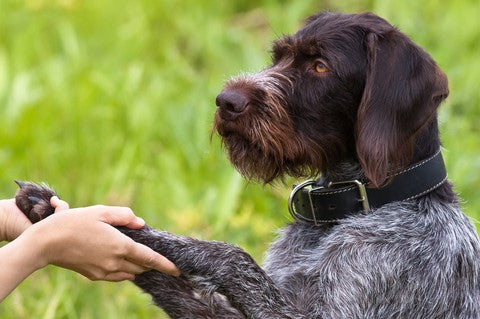Be on paw patrol

Your dog is likely to spend most of the day running, playing fetch and going for walks, and this puts pressure on those paws. Your dog's pads work by absorbing shock and providing support on the rough ground.
Here are some tips on how to keep your dog's paws in top form for all conditions.
Do a regular paw check
Your dog's pads are just as vulnerable as the skin on our feet, but without the protection of shoes they have direct contact with different surfaces. This is why it is important to check them regularly. The main problems you will need to look for are long nails, dry skin, thorns, sores and cuts; especially after a walk.
Pristine paws
It is very easy for your dog to pick up grass seeds, burs, grit and dirt in between their toes; it can become lodged and lead to irritations or chafe on their skin. After checking paws, if necessary clean any dirt with a light soap, rinse thoroughly and thoroughly dry. Avoid doing this too often as moisture can open up the skin to infection.
Puppy Pedi
The most obvious sign that your dog's nails are too long is being able to hear them clicking along the ground when they walk. Whilst most dogs' nails naturally wear down from hard surfaces, sometimes this is not enough and they may need a little trim. If you're doing this yourself be careful not to trim their nails too much as you risk making contact with blood vessels and nerve endings. The hair on your dogs' feet is as important as pads and nails, offering protection to the skin. But too much hair can cause matting allowing dirt to get stuck in the paw, and in the winter, it may also be a problem trapping clumps of ice or snow. If your dog has particularly thick or long hair it may be a good idea to trim a little back for their comfort.
Moisturisers and protection
The rough or hard surfaces your dog spends a lot of time walking on can lead to paws becoming sensitive and worn down, and in turn could end up being painful. If your pet is particularly vulnerable to this, you could use a cream to provide a barrier and protection. There are also specially developed moisturising creams for pets to help prevent pads from cracking.
Take care during different weather climates
Summer
At the hottest time of the year, the pavement beneath your dog's paws can become a serious hazard, resulting in painful burns and blisters on their pads. Always check if the surface is too hot by placing your palm on the pavement for five seconds, if you can't do this comfortably, then the surface is too hot for your dog to walk on. On those hot Summer days, aim to walk your dog in the shade, on grass or early in the morning before the tarmac has heated up.
Winter
In the Wintertime the combination of cold weather, moist surfaces and warm conditions in the home can cause your dog's pads to dry out, resulting in them becoming chapped and cracking. When it becomes very cold and icy people start to use de-icers and salt, be aware that these are toxic to dogs that lick their paws, and some can burn the pads. If you feel there is some in your area, rinse your dog's paws with warm water after a walk. It would also be beneficial to apply a paw balm to protect the pad before taking them out.
